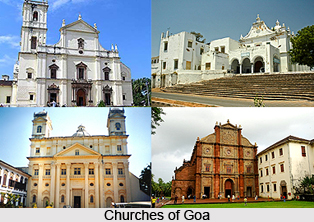The state of Goa on the west coast of India is renowned for its places of worship and world heritage architecture. It offers a unique type of architecture. Most of the architectural specimens of this state generate the flavour of the Portuguese style of architecture. Monuments built in the Mughal architectural style are also seen in Goa. The structural design of the typical architecture of Goa is uncomplicated as perceived in the churches and houses. The Indo Christian style of architecture in Goa is a special feature of Indian architecture.
Goa finds its name mentioned in the epic, Mahabharata and also in some sacred Hindu texts. In the third century B.C. Goa was a part of the Maurya Empire and was under the rule of emperor Ashoka. In the fourteenth century it came under the Delhi sultanates and subsequently came under the dominion of the Portuguese. The Portuguese army took over this place from the Muslims in 1510 and made it their base for trade relations between Asia and Portugal. The Portuguese converted a large fraction of their subjects in Goa to Christianity.
 The state of Goa is celebrated for its outstanding beaches, churches, and temples. The Bom Jesus cathedral is another eminent attraction in Goa. The Fort Aguada too is a chief tourist pull. Recently a Wax Museum on Indian history, culture and heritage has also opened in Old Goa.
The state of Goa is celebrated for its outstanding beaches, churches, and temples. The Bom Jesus cathedral is another eminent attraction in Goa. The Fort Aguada too is a chief tourist pull. Recently a Wax Museum on Indian history, culture and heritage has also opened in Old Goa.
The construction of Se Cathedral in old Goa began in 1562 and finished in 1619. Built in the orthodox Renaissance style, it has a serene appearance. Of the two bell tow¬ers on either side, one had collapsed and now just one remains. The Convent of Saint Cajetan in old Goa is a spectacular Baroque masterpiece. The construction of Bom Jesus church started in 1549 and finished in 1605. The style is a blend of the Renaissance and Baroque styles. Unlike other churches, the plaster on the facade of this church was removed at some point in time. The exterior is a rich Baroque, while the interior is comparatively plain and simple. The Portuguese, completely destroyed Hindu temples and built an entirely new, European style building in its place. As a result, there is no blending of Hindu and Christian architecture in Goa. Even then though the architects were Portuguese, the artisans were Indians, a fact that is reflected in the altar of convent of St. Francis of Assisi church that has woodwork in the south Indian style. The interior of this church, with a deep nave and side aisles is very interesting. It is completely sculpted and frescoed and reflects an austere beauty.
The temples around Ponda are in a style of temple architecture, so unique, that it cannot be seen anywhere else in India. The architects and artisans of the time were building Christian churches and they excelled at this art. When they built Hindu temples, they incorporated this art into the temples, which gave rise to a unique blend of styles, the Indo-Christian style of architecture. The Shanti Durga temple was built by a Maratha minister, by taking over an existing building in the precincts.
 The roofs are tiled and over the sanctum are a four storeyed, domed tower, instead of the usual shikhara. In its details, the building appears western. Artisans living in Goa started building Hindu temples, in the same style being used for Christian churches, at that time. No other temple reflects the style used for Christian churches, as much as the Mangueshi Temple. There are absolutely no sculptures on the outer walls, which is the case in most temples in Goa. Nagueshi Temple resembles the Shanti Durga Temple. Goa was also under the Mughal rule and thus one finds monuments built in the typical Mughal style complete with the domes.
The roofs are tiled and over the sanctum are a four storeyed, domed tower, instead of the usual shikhara. In its details, the building appears western. Artisans living in Goa started building Hindu temples, in the same style being used for Christian churches, at that time. No other temple reflects the style used for Christian churches, as much as the Mangueshi Temple. There are absolutely no sculptures on the outer walls, which is the case in most temples in Goa. Nagueshi Temple resembles the Shanti Durga Temple. Goa was also under the Mughal rule and thus one finds monuments built in the typical Mughal style complete with the domes.
Thus architecture of Goa is a delightful combination of a variety of architectural style which is unique in its own way.



















